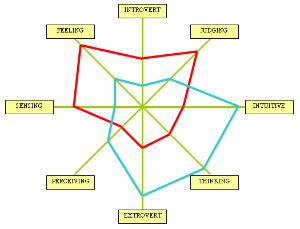Leadership - Style spider
Style spider
Style
Each person has a style of how they behave. This is made up of a variety of elements. Depending on what elements you choose you can compare the leadership styles of different people. In the case of the Myers-Briggs Type Indicator® you may choose to compare the 8 key ‘types’ that are described as 4 pairs which are opposite in effect.
These were.
- Introvert (I) of extrovert (E)
- Sensing (S) or intuitive (I)
- Thinking (T) or feeling (F)
- Judging (J) or perceiving (P)
For each of these ‘types’ you can estimate the value you might give the person you are comparing against. You can do the same for yourself.
This is another example of trying to know yourself.
Let us say you were evaluating your boss. You may come up with the style spider as in the above diagram.
Let us say that you evaluate your boss as the red spider graph and yourself as the blue graph.
It is clear that there is an area of overlap in the way you both approach leadership, there is some common ground.
If you are trying to influence your boss to accept some of your ideas it is not good practice to try to operate in this overlap.
Whilst you may both be able to operate in this area neither of you will be extremely effective.
For example, in terms of ‘thinking’ if you operate at a lower level and modify your approach from ‘logical’ to being a little more ‘feeling’ you will be operating at the low end of your comfort zone. It will be someway towards your boss’s ‘feeling’ zone in being ‘empathic and understanding’ but because it is not fully attuned to his or her way of thinking may fall short of full impact.
What you are trying to do is to act out a role by fully tuning in to the style of your boss’s level of understanding and the way he accumulates information before he or she comes to a decision. You need to go out of your comfort zone temporarily in order to fully access the receptors of your boss.
In your boss’s case if you can put forward your argument in the following manner you will have a great chance of succeeding.
Show a high level of understanding and avoid the cold assessment of the situation with figures and statistics.
Give your boss time to digest the idea as he or she is not as extrovert as you and will wish to consider the information carefully before arriving at a decision.
Indicate the importance of the idea to the work place as he will value this. Highlight the benefits and practicalities of the proposal.
You are trying to pander to his or her best attributes.



